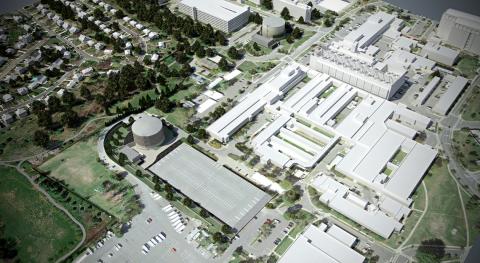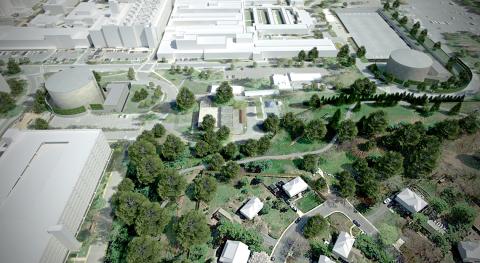IWS and TES
Construction Begins on Water, Thermal Storage Systems

Construction began on Mar. 1 for an industrial water storage system and a thermal energy storage system—both on the south side of campus—that will greatly increase the efficiency and reliability of the NIH Central Utility Plant (CUP). The projects are intended to ensure that NIH research and patient care can continue uninterrupted if there is an unexpected power outage or disruption in public utility services.
Large research campuses such as NIH require a reliable chilled water supply to control building temperature and humidity to rigorous specifications and to operate critical equipment. Without this ability, many NIH functions would have to be curtailed. Currently, the Washington Suburban Sanitary Commission supplies water to NIH.
In December 2008, a 66-inch water main broke beneath the 8500 block of River Rd. in Carderock. This caused NIH to experience low water pressure. The event prompted the Office of Research Facilities to commission a study of NIH’s water needs in case of possible future disruptions. The study recommended that NIH expand its water storage capacity to ensure the availability of chilled water at all times. The two new systems, under the supervision of ORF’s Gias Ahmad, will serve this purpose.
The industrial water storage (IWS) system includes a 5-million-gallon water tank at parking lot 41 and will supplement the existing 5,000-ton chillers and cooling towers in the CUP. The tank, 65 feet high and 120 feet in diameter, will increase water capacity and provide a backup for chilled feed water to offset evaporation and also provide boiler feed water. This will allow NIH to meet the need for water for a few days if a water supply interruption occurs, ensuring reliable cooling and heating to campus buildings.

During construction of the IWS system, part of lot 41 will close, resulting in the loss of roughly 300 parking spaces. To minimize disruption, stacked parking will resume in MLP-8. The Natcher Bldg. garage and MLP-7 are nearby parking alternatives for those who use lot 41. A new surface parking lot will be built near the tank, which will partially offset the spaces affected by the IWS tank.
Construction is also under way for a second, larger water facility, the thermal energy storage (TES) system, on the Bldg. 34 site. It will hold 8 million gallons of chilled water and stand 100 feet high, with the same diameter as the IWS tank. Bldg. 34, the old campus utility plant, will be demolished. Construction on both the IWS and TES systems is expected to be complete by October 2017.
Thermal storage is a low-cost, highly efficient form of energy storage. Combined with other energy sources, thermal storage provides a “green” tool that can help in achieving LEED certification for the building or facility owner. Off-peak energy consumption (power used during the night) can be utilized to meet on-peak demand (power used during the day) by producing an energy source locally at night when it is more efficient and cheaper to generate and using it during peak demand times. Utility companies charge more for on-peak power consumption than for off-peak power consumption and also charge for peak power use. Thus, thermal storage helps reduce peak power demand.
Other advantages of thermal storage include:
- Reduced utility-bill peak demand resulting in decreased electrical costs
- Reduced strain on the power grid—using nighttime energy balances the distribution of energy needs 24 hours a day so there isn’t as much peak demand during the daytime
- Reduced energy consumption
NIH’s cooling load is one of NIH’s largest single utility costs. When combined with buildings’ energy use, the time of peak cooling energy needs produces the highest electrical demand. That peak electrical demand is not only costly to NIH, but also creates challenges for the electric utility serving campus. Adding chilled water thermal storage can make existing chillers serve a far greater load than the installed equipment capacity.
